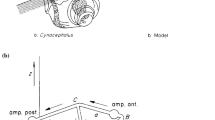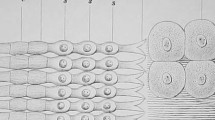Summary
Action potentials in directional statocyst interneurons are measured during sinusoidal oscillation of the crabCarcinus around horizontal axes. Peak response of the interneurons precede peak position of the animal by 120 ° (Fig. 3). Optimum response of an interneuron occurs when the plane of oscillation of the crab coincides with the circumferential plane of the vertical canal of the statocyst providing input to the interneuron in question (Fig. 6). Directionality is explained in terms of unidirectional sensory receptors inCarcinus statocyst. Increased phase lead of response over peak position of the crab is explained in terms of reduced viscous damping in the ‘open’ statocyst.
Similar content being viewed by others
References
Cohen, M.J., Dijkgraaf, S.: Mechano-reception. In: The physiology of Crustacea, Vol. II. (T.H. Waterman, ed.), pp. 65–108. New York-London: Acad. press 1961
Fraser, P.J.: Interneurones in crab connectives (Carcinus maenas (L.): giant fibres. J. exp. Biol.61, 593–613 (1974a)
Fraser, P.J.: Interneurones in crab connectives (Carcinus maenas (L.): directional statocyst fibres. J. exp. Biol.61, 615–628 (1974b)
Fraser, P.J.: Free hook hair and thread hair input to fibre 5 in the mud crab,Scylla serrata, during antennule rotation. J. comp. Physiol.103, 291–313 (1975a)
Fraser, P.J.: Three classes of input to a semicircular canal interneuron in the crab,Scylla serrata, and a possible output. J. comp. Physiol.104, 261–271 (1975b)
Fraser, P.J., Sandeman, D.C.: Effects of angular and linear accelerations on semicircular canal interneurons of the crabScylla serrata. J. comp. Physiol.96, 205–221 (1975)
Hensen, V.: Studien über das Gehörorgan der Decapoden. Z. wiss. Zool.13, 317–412 (1863)
Melvill Jones, G.: The functional significance of semicircular canal size. In: Vestibular system, Part I Basic mechanisms. Handbook of sensory physiology, Vol. VI/1 (H.H. Kornhuber, ed.), pp. 171–184. Berlin-Heidelberg-New York: Springer 1974
Prentiss, C.W.: The otocyst of decapod Crustacea. Bull. Mus. Comp. Zool. Harvard36, 167–254 (1901)
Sandeman, D.C., Okajima, A.: Statocyst-induced eye movements in the crabScylla serrata I. The sensory input from the statocyst. J. exp. Biol.57, 187–204 (1972)
Silvey, G.E., Dunn, P.A., Sandeman, D.C.: Integration between statocyst sensory neurons and oculomotor neurons in the crabScylla serrata. II. The thread hair sensory receptors. J. comp. Phy0siol.108, 45–52 (1976)
Author information
Authors and Affiliations
Additional information
The author is grateful to the Science Research Council for financial assistance.
Rights and permissions
About this article
Cite this article
Fraser, P.J. How morphology of semicircular canals affects transduction, as shown by response characteristics of statocyst interneurons in the crabCarcinus maenas (L.). J. Comp. Physiol. 115, 135–145 (1977). https://doi.org/10.1007/BF00667790
Received:
Issue Date:
DOI: https://doi.org/10.1007/BF00667790




